yobbo II
National Hazard
   
Posts: 762
Registered: 28-3-2016
Member Is Offline
Mood: No Mood
|
|
Welch duoseal 1397
Hello,
I have a dismantled a Welch duoseal 1397 vacuum pump. There is a bellows controlled valve internally in the pump which has come apart (the bellows
part).
It is contained in the 'lump' that sticks out in the picture.
Has anyone any experience with this type of pump.
The valve connects/disconnects parts of the pump together in a complicated way that I cannot quite figure out and I suppose I am taking the easy
option and asking first.
Will the pump function without the valve? It was not put there as an ornament but the pump might work well enough (less efficienctly or somesuch) with
this valve not functioning properly.
The bellows of the valve has burst/corroded.
Whs there a vacuum inside this bellows when new or atmospheric presssure?
I may be able to solder again if its just atmospheric.
There is no mention of this valve in any spare parts kits for the pump.
Funny too the valve is not in the exploded diagram of the pump which is online.
https://www.google.com/url?sa=t&rct=j&q=&esrc=s&...
Thanks for looking,
Yob
[file]95379[/file] [file]95381[/file]
[Edited on 10-11-2022 by yobbo II]
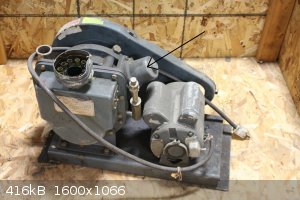 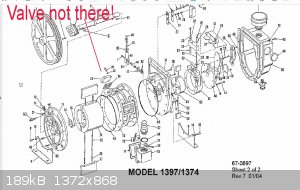
|
|
|
Rainwater
National Hazard
   
Posts: 919
Registered: 22-12-2021
Member Is Offline
Mood: indisposition to activity
|
|
Attachment: OwnersManDuoSeal_1400_02_05_1399_97_92_80_76_74 Revised2004.pdf (1MB)
This file has been downloaded 251 times
Page 16
Looks like you have a 1374B-01 or 1397B-01
1397B-01 page 22/23 part#23 show a "Cover Plate for Conversion Valve".
Page 42 has company contact information. I've called them before. That are very helpful when it comes to getting replacement parts.
"You can't do that" - challenge accepted
|
|
|
yobbo II
National Hazard
   
Posts: 762
Registered: 28-3-2016
Member Is Offline
Mood: No Mood
|
|
THanks for reply.
I found another exploded diagram that shows the valve.
What is its function?
Yob
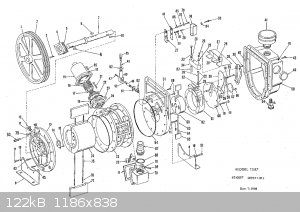
|
|
|
Texium
Administrator
       
Posts: 4580
Registered: 11-1-2014
Location: Salt Lake City
Member Is Offline
Mood: PhD candidate!
|
|
Hmm, strange. I have no idea what that's for. It seems like you have quite a complicated model there. I have rebuilt a couple 1399's and a 1400, and
both are much simpler than the 1397. My first thought was that if they sold the cover plate shown in the first diagram (part no. 61-8880 plus gasket
41-1508), you could just get one of those and stick it on there, not having to worry about the valve, but it appears it's not available. The gasket is
available as part of the minor repair kit for the model, which is very expensive from Welch, but should be available more affordably from third party
companies. Might still be worth giving Welch a call though.
To anyone else who is in the market for a Welch pump, I highly recommend the 1399, as its design is very simple and robust, and although it is single
stage, it is still quite good for general lab use and air-free chemistry. I use one on my Schlenk line at work and it hasn't let me down. If you
absolutely need a 2 stage pump, the 1400 is probably the best value. While obviously a little more complicated inside than the 1399, it uses the same
parts, but with two rotors/two sets of vanes.
|
|
|
yobbo II
National Hazard
   
Posts: 762
Registered: 28-3-2016
Member Is Offline
Mood: No Mood
|
|
Thanks for the help.
I had to laugh. I emailed a company that was selling/supplying parts for Welch pumps asking what a Compensation Valve actually did and if they could
supply a Compensation Valve.
I got back a reply, "Never heard of one of those'.
I re-emailed supplying a picture and diagram (like above) showning the valve and got back a reply,
"Oh that. Well, they actually found out that actually did nothing. Newer versions of the pump don’t have it. Did you want me to see if I can get
you the components in there? There is also an adaptor that just blocks that off too.
Will high quality (Tec. 7) do OK as a sealer on joints for this type pump/application.
Yob
[Edited on 12-11-2022 by yobbo II]
|
|
|
yobbo II
National Hazard
   
Posts: 762
Registered: 28-3-2016
Member Is Offline
Mood: No Mood
|
|
Hello,
Pictured is the 'end plate' of the 1397 vacuum pump and also the body showing the vanes and rotor.
As you can see there is no track for an O ring or no sign where an O ring used to be (if it was ever there) from the last time it was assembled.
Looking at a kit for the pump (and looking at the exploded diagrams above) two O rings are clearly seen.
KIT: https://www.vacuumpumpsupply.com/welch-1397-minor-repair-kit...
How does this square with my pump?
Surley I cannot simply crush an O ring between two perfectly flat surfaces?
I have already assembled the pump using silicon sealer as the gasket between the two flat surfaces. It rotates OK. Have not run the pump yet using a
motor.
I need a new main shaft seal but I am hopeing to obtain a cheap viton 'flat shaped' O Ring (wish me luck!)
Something like this:
https://www.ebay.co.uk/itm/232506206337?_trkparms=amclksrc%3...
Thanks for your time.
Yob
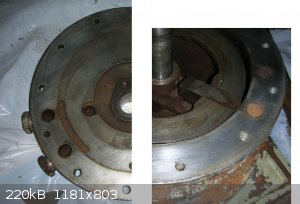
[Edited on 22-11-2022 by yobbo II]
|
|
|
wg48temp9
National Hazard
   
Posts: 783
Registered: 30-12-2018
Location: not so United Kingdom
Member Is Offline
|
|
yobbo ll:
Both end plates on both stages need to be metal to metal in order to accurately define the end clearance between the rotor and the end plates. So no
gasket or sealant should be used.
On pump stages that are under oil its usual to not have grooved O-rings to seal the end plates. The first stage of your pump appears to not be under
oil so it should have a grooved O-ring to seal it as the diagram shows. Note the final stage is under oil and does not have a O-ring. If you look at
model 67-0894 which has both stages under oil it has no O-rings on the end plates of both stages. Perhaps your pump was put together with the wrong
end plates or it was repaired with parts from the 67-0894 model.
If you are only intending to use the pump for chemistry and not electrical gas discharge experiments perhaps using a suitable (vacuum oil resistant)
very thin sealant will be OK.
Note: one thing you can check is the wear on the end plates and the clearance between the rotor or blades and end plates.
(in your picture the end clearance on one blade looks too large)
It is possible to lap the end plates and barrel but its easy to do more harm than good.
PS I suggest you don't use a building sealant /adhesive., Use tube of sealant for car oil pans or find a suitable version of Loctite sealant.
PSS I noticed your end plate has a short groove in the area swept by the blades, near the outlet. I have noticed that on other vacuum pumps too. I
suspect it a bypass to prevent oil lock. I guess it limits the final vacuum achieved. So perhaps a thin sealant (not building stuff) will not reduce
performance too much.
I am wg48 but not on my usual pc hence the temp handle.
Thank goodness for Fleming and the fungi.
Old codger' lives matters, wear a mask and help save them.
Be aware of demagoguery, keep your frontal lobes fully engaged.
I don't know who invented mRNA vaccines but they should get a fancy medal and I hope they made a shed load of money from it.
|
|
|
yobbo II
National Hazard
   
Posts: 762
Registered: 28-3-2016
Member Is Offline
Mood: No Mood
|
|
My pump is old. It was purchased in about 1986 and was second hand. An exploded diagram of older pumps is here:
https://www.repairfaq.org/sam/laser/welch_owners_manual1975....
No sign of o rings on the main caseing ends.
The rpm needed is 400. I am running at 500. Is that a problem.
I replaces the shaft seal (which was dripping oil) with two rubber seals and machined graphite moving seals.
I need to get a vacuum gauge to see how it is doing.
I will allow me to test the pump. A new one is about 300 bucks.
wg48Temp9 said
"Note: one thing you can check is the wear on the end plates and the clearance between the rotor or blades and end plates.
(in your picture the end clearance on one blade looks too large)"
I think the picture does not do the pump justice. The gap is not that big.
Yob
|
|
|
yobbo II
National Hazard
   
Posts: 762
Registered: 28-3-2016
Member Is Offline
Mood: No Mood
|
|
My pump is old. It was purchased in about 1986 and was second hand. An exploded diagram of older pumps is here:
https://www.repairfaq.org/sam/laser/welch_owners_manual1975....
No sign of o rings on the main caseing ends.
The rpm needed is 400. I am running at 500. Is that a problem.
The pump oil is around 65C when run for an hour or so.
I replaced the shaft seal (which was dripping oil) with two rubber seals and machined graphite moving seals.
I need to get a vacuum gauge to see how it is doing.
It will allow me to test the pump. A new one is about 300 bucks.
wg48Temp9 said
"Note: one thing you can check is the wear on the end plates and the clearance between the rotor or blades and end plates.
(in your picture the end clearance on one blade looks too large)"
I think the picture does not do the pump justice. The gap is not that big.
Yob
[Edited on 16-12-2022 by yobbo II]
[Edited on 16-12-2022 by yobbo II]
|
|
|
wg48temp9
National Hazard
   
Posts: 783
Registered: 30-12-2018
Location: not so United Kingdom
Member Is Offline
|
|
As I explained in my previous post if the outer edge of the junction between the end plates (casing ends) and the barrel is submerged in oil, as is in
the above pump. I would not expect O-rings seal.
I would not expect the increased rpm (+25%) to be a significant problem. It will increase the wear on the sliding parts of the pump and increase its
operating temperature so keep monitoring the temperature. On the other hand it will increase the pumping speed.
I am wg48 but not on my usual pc hence the temp handle.
Thank goodness for Fleming and the fungi.
Old codger' lives matters, wear a mask and help save them.
Be aware of demagoguery, keep your frontal lobes fully engaged.
I don't know who invented mRNA vaccines but they should get a fancy medal and I hope they made a shed load of money from it.
|
|
|
yobbo II
National Hazard
   
Posts: 762
Registered: 28-3-2016
Member Is Offline
Mood: No Mood
|
|
Cranked up the pump and measured the vacuum using an old home made McLeod gauge of iffy internal dimentions.
The pump as is stands is capable of giving a vacuum of 0.01 to 0.002 Torr. It depends on what dimensions I use for the capilary tube in the gauge for
the calculation of vacuum. I have forgotton what its dimensions were ( its decades ago). It is difficult to measure/guess the internal dia. of the
tube due to the magnifying effect of the tube itself.
I am using very plain vacuum oil, Airtech V100, and the pump was cool. I will pump for an hour or so next time to let it heat up.
What are the connections on a Welch pump called?
The one I have is the same as the one pictured.
I machined the outlet so I could insert (and seal in) a more up to date (I presume) type. KF 40.
I have a capacitive diaphram type gauge that goes from zero to 1 Torr. Not set up yet.
Thanks for the help
Yob
[Edited on 13-1-2023 by yobbo II]
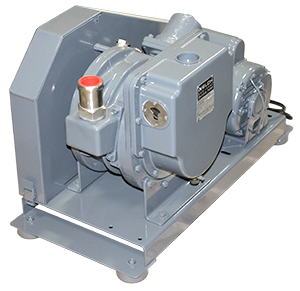
[Edited on 13-1-2023 by yobbo II]
|
|
|